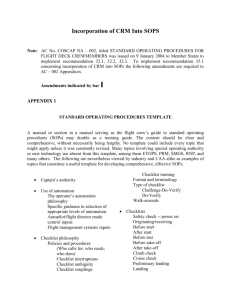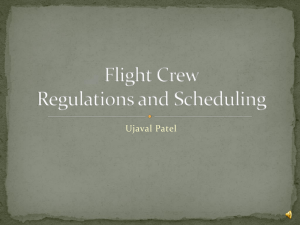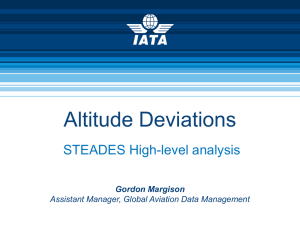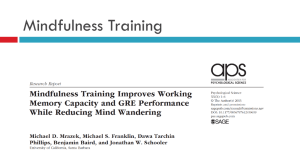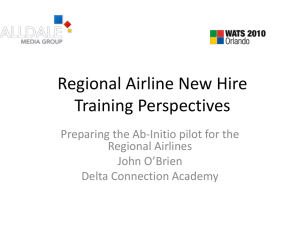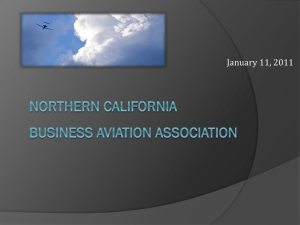Pilot Monitoring V 2.1
advertisement
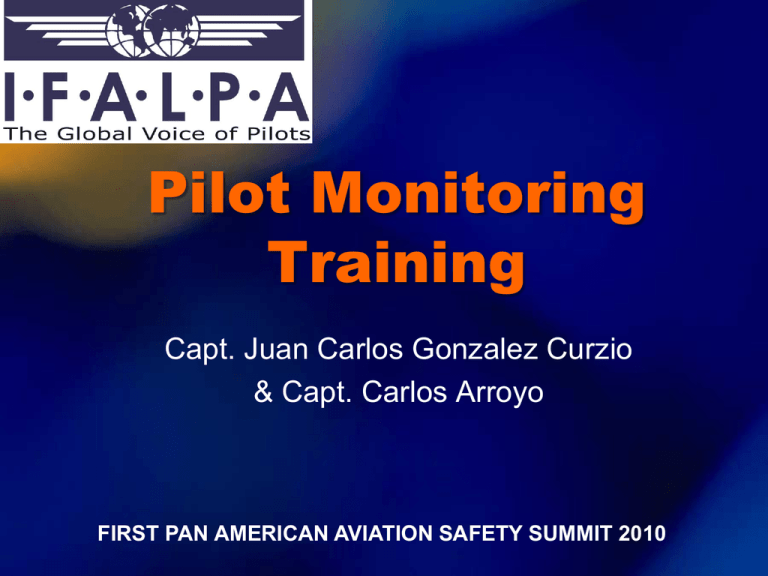
Pilot Monitoring Training Capt. Juan Carlos Gonzalez Curzio & Capt. Carlos Arroyo FIRST PAN AMERICAN AVIATION SAFETY SUMMIT 2010 Enhancing Flight-crew Monitoring Skills Can Increase Flight Safety 2 3 Improving Monitoring “First, we must change our approach to monitoring …” “Good monitoring skills are not inherent in a pilot as they progress in their careers. Therefore, effective monitoring techniques must be trained and rewarded” Captain Frank J. Tullo “Aviation Week & Space Technology” May 21, 2001 4 • October 25, 2002 Eveleth, Minnesota 5 According to NTSB “During the later stages of the approach, the flight crew failed to monitor the airplane’s airspeed and allowed it to decrease to a dangerously low level (as low as about 50 knots below the company’s recommended approach airspeed) and to remain below the recommended approach airspeed for about 50 seconds.” Source: NTSB/AAR-03/03. 6 “If the First Officer had monitored the approach on the instruments...he would have been better able to notice and immediately call the Captain’s attention to the altitude deviation below the minimum descent altitude.” Source: NTSB/AAR-96/05. 7 ….And the story continues • Colgan Air 3407 February 12, 2009 8 Introduction •Each crewmember must carefully monitor the aircraft’s flight path and systems, and actively cross-check the actions of each other. • Effective monitoring and cross-checking can literally be the last line of defense – When this layer of defense is absent the error may go undetected, leading to adverse safety consequences 9 Good monitoring is important • By better monitoring and crosschecking, a crewmember will be more likely to catch an error or unsafe act • This detection may break a chain of events leading to an accident scenario 10 Why improve monitoring? - Accident Data • Inadequate crew monitoring or challenging was a factor in 84% of 37 crew-caused air carrier accidents reviewed in a NTSB safety study. – 76% of the monitoring/challenging errors involved failure to catch something that was causal to the accident – 17% of the monitoring/challenging errors were failure to catch something that contributed to the accident’s cause 11 Why improve monitoring? - Accident Data • Poor monitoring was a factor in 63% of the ALA accidents reviewed by the FSF ALAR working groups. • 50% of the CFIT accidents reviewed by ICAO to support the FSF CFIT efforts involved poor monitoring. 12 Why improve monitoring? - Incident Data • Researchers examined 200 incident reports submitted to NASA ASRS • They found evidence that inadequate monitoring can lead to adverse safety consequences – Altitude deviations – CFIT – Stall – Loss of aircraft control – Course/Heading deviations 13 Why improve monitoring? - LOSA Data • Roughly 64% of “unintentional errors” in the University of Texas LOSA archive were undetected by flight crew. • In a recent LOSA, 19% of errors could have been eliminated by more effective crew monitoring and cross-checking. • In that same LOSA, 69% of “undesired states” could have been eliminated by more effective monitoring. 14 Underlying factors associated with poor monitoring 1. Until now, the industry has not made monitoring a primary task. – When listing PNF duties, we often list duties such as handling radio communications, keeping flight logs and operating gear and flaps. – Monitoring is not one of the duties primarily listed, but rather it seems to be treated as a secondary task, or not addressed at all. 15 Underlying factors associated with poor monitoring 2. Effective monitoring is not easy and Intuitive – requires a skill and discipline 16 Underlying factors associated with poor monitoring 3. There is somewhat of a monitoring paradox that works against effective Monitoring. – Serious errors do not occur frequently which can lead to boredom and complacency “A low-probability, high-criticality error is exactly the one that must be caught and corrected.” 17 Underlying factors associated with poor monitoring 4. Although traditional CRM courses have generally improved the ability of crewmembers to challenge others when a situation appears unsafe or unwise… • many of these courses provide little or no explicit guidance on how to improve monitoring. 18 Underlying factors associated with poor monitoring 5. We seem satisfied that we cannot improve monitoring, and simply explain it as, “Humans just are not good monitors.” – While it may be true that humans are not naturally good monitors, crew monitoring performance can be significantly improved through policy changes and crewmember training. 19 NASA ASRS Monitoring Study • This study was a good resource for helping us get stared and providing data • The objectives of the study were to identify factors that contribute to monitoring errors, and • Offer operationally- oriented recommendations to – increase awareness of this subject – improve crew monitoring 20 ASRS Monitoring Study: Flight Phase where Monitoring Errors Occurred 21 ASRS Study: Number of tasks crew was doing when error occurred* 22 ASRS study significant findings • 76 percent of monitoring errors occurred when aircraft was climbing, descending or on approach (“vertical flight phase”) • 30 percent of the reports indicated that pilots were programming the FMS shortly before or during the monitoring error 23 ASRS Study Cornerstones for Improving Monitoring • Management and regulatory officials must provide crews with clearly thought-out procedures and guidelines to maximize monitoring. • Flight crews must constantly exercise monitoring discipline and use operational guidelines designed to improve monitoring. 24 Approach to Improving Monitoring • Developing well thought-out SOPs • Training monitoring skills • Practicing those skills 25 Approach to Improving Monitoring • Developing well thought-out SOPs • Training monitoring skills • Practicing those skills 26 Developing SOPs AC 120-71A “Standard Operating Procedures” • Revised in February 2003, this AC contains template SOPs that can be adopted by operators to improve monitoring. 27 28 Developing SOPs • Change title of “Pilot -Not-Flying” (PNF) to “Pilot Monitoring” (PM) – Describes what the pilot should be doing (monitoring) versus what he/she is not doing (not flying) 29 Developing SOPs Monitoring Responsibility – The PF will monitor/control the aircraft, regardless of the level of automation employed. – The PM will monitor the aircraft and actions of the PF. Monitoring is a primary responsibility of each pilot. 30 Developing SOPs • Both pilots will have taxi charts available, when necessary • Both pilots will monitor taxi clearance • Captain will verbalize to FO any hold short instructions – FO will request confirmation from Captain if not received 31 Developing SOPs When approaching an entrance to an active runway, both pilots will ensure the hold short or crossing clearance is complied-with before continuing with non-monitoring tasks (FMS programming, ACARS, company radio calls, etc.) 32 Developing SOPs During high workload, FMS inputs will be made by PM, upon the request of PF. High workload examples – below 10,000 feet – within 1000 feet of level off or Transition Altitude. 33 34 Developing SOPs • Perform non-essential duties/activities during lowest workload periods (e.g., cruise altitude or level flight) • When able, brief anticipated approach prior to top of descent • PF will brief PM where or when delayed climb or descent will begin • During the last 1000 feet of altitude change, both pilots will focus on making sure the aircraft levels at the assigned altitude • Airline eliminated “10,000 ft announcements” and specified that the pre-arrival announcement be conducted just after leaving cruise altitude. 35 Approach to Improving Monitoring • Developing well thought-out SOPs • Training monitoring skills • Practicing those skills 36 Training monitoring skills • NTSB safety study states that simulator training provides a good opportunity to teach and practice monitoring and crosschecking. – NTSB Safety Study of Crew-caused Accidents 37 Training monitoring skills • Starting from day 1 of training, ensure all monitoring/ crosschecking SOPs are followed. • Discuss how barriers are cut in half with one pilot out of the loop. • Train workload management so at least one pilot is always monitoring during low workload and both pilots are monitoring as much as possible during high workload. • Acknowledge good monitoring. – Introduction of occasional subtle failures in simulator training, such as failure of automation to level-off at proper altitude 38 Approach to Improving Monitoring • Developing well thought-out SOPs • Training monitoring skills • Practicing those skills 39 Practicing monitoring skills • Know and comply with SOPs • Pilots must “actively monitor” the aircraft. • This means that they must mentally fly the aircraft, even when the autopilot or other pilot is flying. – Monitor the flight instruments just as you would when hand flying. – If the aircraft (or other pilot) is not doing what it is supposed to do, actions should be taken to rectify the situation. 40 Practicing monitoring skills • In approximately one-third of the cases studied by researchers, pilots “failed to monitor errors, often because they had planned their own workload poorly and were doing something else at a critical time.” – Jentsch, Martin, Bowers (1997) • Threat and Error Management with a focus on monitoring and cross-checking is a good way to teach pilots better workload prioritization skills. 41 Practicing monitoring skills • Pilots should recognize those flight phases where poor monitoring can be most problematic. • Strategically plan workload to maximize monitoring during those areas of vulnerability (AOV) – Examples of non-monitoring tasks that should be conducted during lower AOV include stowing charts, programming the FMS, getting ATIS, accomplishing approach briefing, PA announcements, non-essential conversation, etc. 42 Practicing monitoring skills 43 Practicing monitoring skills •By pre-briefing the approach in low workload periods, greater attention can be devoted to monitoring/cross-checking during descent. • In fact, LOSA data showed that crews who briefed the approach after Top-Of- Descent (TOD) committed 1.6 times more errors during the descent/ approach/land flight phase than crews who briefed prior to TOD. 44 Practicing monitoring skills • One way of assessing your current monitoring ability is to ask: “How often do I miss making the 1,000’ to level –off altitude callout?” – When this callout is missed, chances are that you are not actively monitoring the aircraft. 45 Practicing monitoring skills Both Pilots Creates Barriers PV PM Practicing monitoring skills When one Pilot is out of the loop……………. PV PM Practicing monitoring skills …..Half of the barriers are lost PV PM Practicing monitoring skills If both Pilots are out of the loop… ¿Who is taking care of bussines? PV PM MONITORING AND CHALLENGE Pilot Monitoring (PM) Take Action Crosschecking Steps Express your view Error Resolved MONITORING AND CHALLENGE (PM) Take Action Express your view Express your view Error Resolve Practicing monitoring skills • We need a ACTIVE and PROACTIVE monitoring ……………...….…¡We don´t want this! Practicing monitoring skills Paradigm shift • It must become accepted that monitoring is a “core skill,” just as it is currently accepted that a good pilot must posses good “stick and rudder” and effective communicational skills. 54 Summary • Inadequate flight crew monitoring has been cited by a number of sources as a problem for aviation safety. • While it is true that humans are not naturally good monitors, crew monitoring performance can be significantly improved through policy changes, training and by pilots following an active monitoring concept. 55 0% Flight Crew 10% 20% 91 Airplane Weather 15 Maintenance 10 Misc./Other 8 Airport/ATC 6 Total with known causes 5 30% 40% 50% 60% 70% 80% 67% 11% 7% 6% 4% 4% Unknown or 135 awaiting reports 65 Total 200 (1992 a 2002) 67.0% 56 0% Flight Crew 84 Airplane 19 Weather 16 Maintenance 7 Misc./Other 5 Airport/ATC 5 Total with known causes Unknown or awaiting reports Total 10% 20% 30% 40% 50% 60% 70% 80% 62% 14% 12% 5% 4% 4% 136 50 186 (1993 a 2003) 62.0% 57 0% Flight Crew 75 Airplane 23 Weather 17 Maintenance 8 Misc./Other 5 Airport/ATC 5 Total with known causes Unknown or awaiting reports Total 10% 20% 30% 40% 50% 60% 70% 80% 56% 17% 13% 6% 4% 4% 133 44 177 (1995 a 2005) 56.0% 58 The challenge Take this concept home with you and implement a program to improve monitoring/cross-checking at your company. 59 “If I had been watching the instruments, I could have prevented the accident." - FO after being involved in fatal loss of control accident 60
